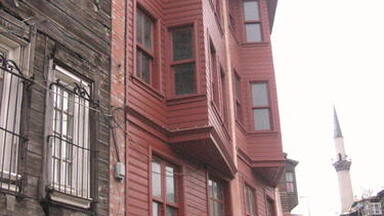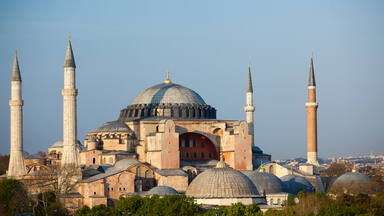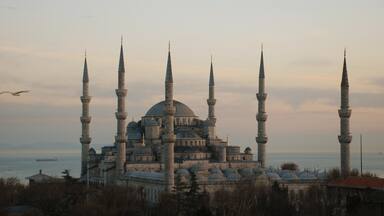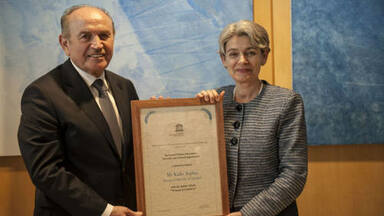Historic Areas of Istanbul
Historic Areas of Istanbul
With its strategic location on the Bosphorus peninsula between the Balkans and Anatolia, the Black Sea and the Mediterranean, Istanbul has been associated with major political, religious and artistic events for more than 2,000 years. Its masterpieces include the ancient Hippodrome of Constantine, the 6th-century Hagia Sophia and the 16th-century Süleymaniye Mosque, all now under threat from population pressure, industrial pollution and uncontrolled urbanization.
Description is available under license CC-BY-SA IGO 3.0
Zones historiques d'Istanbul
Point stratégique sur la péninsule du Bosphore entre les Balkans et l'Anatolie, la mer Noire et la Méditerranée, la ville d'Istanbul a été associée à de grands événements politiques, religieux et artistiques pendant plus de 2000 ans. Ses chefs-d'œuvre comprennent l'ancien hippodrome de Constantin, la basilique Sainte-Sophie qui date du VIe siècle et la mosquée Süleymaniye, du XVIe siècle ; ils sont actuellement menacés par la surpopulation, la pollution industrielle et une urbanisation incontrôlée.
Description is available under license CC-BY-SA IGO 3.0
اسطنبول التاريخية
شكلت مدينة اسطنبول نقطة استراتيجية في شبه جزيرة البوسفور بين البلقان والأناضول والبحر الأسود والبحر المتوسط، وقد ارتبطت بأحداث سياسية ودينية وفنية هامة على مدى أكثر من 2000 سنة. وتشمل تحفها ميدان قسطنطين القديم لسباق الخيل وبازيليك آية صوفيا العائدة الى القرن السادس ومسجد السليمانية العائد الى القرن السادس عشر، وجميعها مهدد حالياً جرّاء الاكتظاظ السكاني والتلوث الصناعي والتنظيم المدني العشوائي.
source: UNESCO/CPE
Description is available under license CC-BY-SA IGO 3.0
伊斯坦布尔历史区域
伊斯坦布尔历史区域位于巴尔干与安纳托利亚、黑海与地中海之间的波斯弗如斯佩宁苏拉。两千多年来,伊斯坦布尔总是与一些重要的政治、宗教和艺术事件联系在一起。它的杰作包括古代君士坦丁堡竞技场、6世纪的哈吉亚•索菲亚教堂和16世纪的苏莱曼清真寺。这些遗迹现在受到了人口过盛、工业污染以及过度城市化的威胁。
source: UNESCO/CPE
Description is available under license CC-BY-SA IGO 3.0
Исторические районы Стамбула
Занимая стратегическое положение на проливе Босфор, между Балканами и Анатолией, и между Черным и Средиземным морями, Стамбул был связан с важнейшими событиями в мире политики, религии и искусства на протяжении более 2 тыс. лет. Его шедевры – древний ипподром Константина, храм Святой Софии VI в. и мечеть Сулеймания XVI в., – находятся теперь под угрозой разрушения из-за перенаселенности города, промышленных загрязнений и неконтролируемой урбанизации.
source: UNESCO/CPE
Description is available under license CC-BY-SA IGO 3.0
Zonas históricas de Estambul
Estratégicamente situada en la península del Bósforo, entre los Balcanes y Anatolia, el Mar Negro y el Mediterráneo, la ciudad de Estambul ha sido el escenario de grandes acontecimientos políticos, religiosos y artísticos durante más de dos mil años. Entre sus numerosos monumentos cabe destacar el antiguo hipódromo de Constantino, la basílica de Santa Sofía, construida en el siglo VI, y la mezquita de Solimán el Magnífico, que data del siglo XVI. La superpoblación, la contaminación industrial y la urbanización incontrolada están poniendo en peligro estas obras maestras.
source: UNESCO/CPE
Description is available under license CC-BY-SA IGO 3.0
イスタンブール歴史地域
ヨーロッパとアジア大陸の接点に位置するイスタンブールは、この両大陸の重要なかけ橋として、またローマ帝国、ビザンチン帝国、オスマン帝国の首都として栄えてきた。アメフト1世のモスクは、オスマン帝国の代表的なモスクの一つで、17世紀初めに建てられ、内装は青色のイズニック・タイルで飾られ、その卓越した美しさからブルー・モスクとよばれている。source: NFUAJ
Historische delen van Istanbul
Door zijn strategische ligging op het Bosporusschiereiland – tussen de Balkan en Anatolië, de Zwarte Zee en de Middellandse Zee – is Istanbul al meer dan 2.000 jaar betrokken bij belangrijke politieke, religieuze en artistieke ontwikkelingen. Het was achtereenvolgens de hoofdstad van het Oost-Romeinse en Ottomaanse Rijk. De uitzonderlijke universele waarde van Istanbul dankt zij aan de unieke integratie van architecturale meesterwerken, waardoor een ontmoeting tussen Europa en Azië plaatvond. Zo zijn er het oude Hippodroom van Constantijn, de 6e-eeuwse Hagia Sophia en de 16e-eeuwse Süleymaniye moskee, die tegenwoordig allemaal bedreigd worden door de bevolkingsgroei, industriële verontreiniging en niet-gecontroleerde verstedelijking.
Source: unesco.nl
Outstanding Universal Value
Brief synthesis
Strategically located on the Bosphorus peninsula between the Balkans and Anatolia, the Black Sea and the Mediterranean, Istanbul was successively the capital of the Eastern Roman Empire, and the Ottoman Empire and has been associated with major events in political history, religious history and art history for more than 2,000 years. The city is situated on a peninsula which is surrounded by the Golden Horn (Haliç), a natural harbor on the north, the Bosphorus on the east and the Marmara Sea on the south. The Historic Peninsula, on which the former Byzantium and Constantinople developed, was surrounded by ancient walls, built initially by Theodosius in the early fifth century.
The Outstanding Universal Value of Istanbul resides in its unique integration of architectural masterpieces that reflect the meeting of Europe and Asia over many centuries, and in its incomparable skyline formed by the creative genius of Byzantine and Ottoman architects.
The distinctive and characteristic skyline of Istanbul was built up over many centuries and encompasses the Hagia Sophia whose vast dome reflects the architectural and decorative expertise of the 6th century, the 15th century Fatih complex and Topkapi Palace - that was continually extended until the 19th century, the Süleymaniye Mosque complex and Sehzade Mosque complex, works of the chief architect Sinan, reflecting the climax of Ottoman architecture in the 16th century, the 17th century Blue Mosque and the slender minarets of the New Mosque near the port completed in 1664.
The four areas of the property are the Archaeological Park, at the tip of the Historic peninsula; the Suleymaniye quarter with Suleymaniye Mosque complex, bazaars and vernacular settlement around it; the Zeyrek area of settlement around the Zeyrek Mosque (the former church of the Pantocrator), and the area along both sides of the Theodosian land walls including remains of the former Blachernae Palace. These areas display architectural achievements of successive imperial periods also including the 17th century Blue Mosque, the Sokollu Mehmet Pasha Mosque, the 16th century Şehzade Mosque complex, the 15th century Topkapi Palace, the hippodrome of Constantine, the aqueduct of Valens, the Justinian churches of Hagia Sophia, St. Irene, Küçük Ayasofya Mosque (the former church of the Sts Sergius and Bacchus), the Pantocrator Monastery founded under John II Comnene by Empress Irene; the former Church of the Holy Saviour of Chora with its mosaics and paintings dating from the 14th and 15th centuries; and many other exceptional examples of various building types including baths, cisterns, and tombs.
Criterion (i): The Historic Areas of Istanbul include monuments recognised as unique architectural masterpieces of Byzantine and Ottoman periods such as Hagia Sophia, which was designed by Anthemios of Tralles and Isidoros of Miletus in 532-537 and the Suleymaniye Mosque complex designed by architect Sinan in 1550-1557.
Criterion (ii): Throughout history the monuments in Istanbul have exerted considerable influence on the development of architecture, monumental arts and the organization of space, both in Europe and the Near East. Thus, the 6,650 meter terrestrial wall of Theodosius II with its second line of defence, created in 447, was one of the leading references for military architecture; Hagia Sophia became a model for an entire family of churches and later mosques, and the mosaics of the palaces and churches of Constantinople influenced both Eastern and Western art.
Criterion (iii): Istanbul bears unique testimony to the Byzantine and Ottoman civilizations through its large number of high quality examples of a great range of building types, some with associated artworks. They include fortifications, churches and palaces with mosaics and frescos, monumental cisterns, tombs, mosques, religious schools and bath buildings. The vernacular housing around major religious monuments in the Süleymaniye and Zeyrek quarters provide exceptional evidence of the late Ottoman urban pattern.
Criterion (iv): The city is an outstanding set of monuments, architectural and technical ensembles that illustrate very distinguished phases of human history. In particular, the Palace of Topkapi and the Suleymaniye Mosque complex with its caravanserai, madrasa, medical school, library, bath building, hospice and imperial tombs, provide supreme examples of ensembles of palaces and religious complexes of the Ottoman period.
Integrity
The Historic Areas of Istanbul include the key attributes that convey the Outstanding Universal Value of Istanbul as the parts of the city that had escaped major changes and deterioration in the 19th and 20th centuries and were already protected by national legislation at the time of inscription.
Vernacular timber housing in the Süleymaniye and Zeyrek quarters, was recognized as vulnerable at the time of inscription. Despite the threat of pressure for change, many efforts have been executed in order to conserve and strengthen the timber structures within the site since then. Changes in the social structure within the area have also affected the use of those structures. The urban fabric is threatened by lack of maintenance and pressure for change. The Metropolitan Municipality is attempting to rehabilitate the area to revive its degraded parts. The revival of the Süleymaniye and Zeyrek quarters is a long project which demands a long and careful process of cleaning, conservation and restoration. The Suleymaniye Complex has retained its structural and architectural integrity, except some minor changes in the commercial part of the compound. Zeyrek Mosque, originally the Church of Pantocrator, has suffered from several earthquakes.
The integrity of the major monuments and archaeological remains within the four Historic Areas are largely intact but they are vulnerable due to the lack of a management plan. With the management plan, which is under approval process by related authority, it is aimed to address all the issues and solve the problems within the site gradually.
The setting of the Historic Areas of Istanbul and the outstanding silhouette of the city are vulnerable to development.
Authenticity
The ability of the monuments and vernacular housing to express truthfully the Outstanding Universal Value of the Historic Areas of Istanbul has been compromised to some extent since inscription in terms of their design and materials. The conservation and restoration works in the setting of the Historic Peninsula are being led and followed by the central and local authorities as well as newly established institutions with the financial funds provided by the legal amendments.
The setting and distinctive skyline of the Historic Peninsula continues to express the Outstanding Universal Value of the property. However the ongoing ability of the wider maritime setting to do this depends on ensuring that development does not compromise views of the skyline.
Protection and management requirements
The Historic Areas of Istanbul is legally protected through national conservation legislation. There is no specific planning legislation to protect World Heritage sites. The management structure for the protection and conservation of the properties includes the shared responsibilities of national government (The Ministry of Culture and Tourism General Directorate of Cultural Assets and Museums, General Directorate of Pious Foundation) local administration and several state institutions. The approval of the Conservation Council has to be obtained for physical interventions and functional changes in registered buildings and conservation sites.
The Site Management Directorate for Cultural and Natural Sites of Istanbul was established within the Istanbul Metropolitan Municipality in 2006 to coordinate management planning processes for World Heritage Sites of Istanbul. The work of the directorate is supported by an Advisory Board and a Coordination and Supervising Board. A site manager has also been appointed. A department was also structured under the Ministry of Culture and Tourism to coordinate the management issues of the World Heritage Sites in Turkey and to collaborate with relevant authorities for the implementation of the World Heritage Convention and the Operational Guidelines.
The first conservation plans for Zeyrek, Suleymaniye and the Land Walls were prepared and approved in 1979 and 1981. A new conservation plan including World Heritage sites was endorsed by the Council of İstanbul Metropolitan Municipality and submitted to the Conservation Council for approval. The impressive skyline of the Historic Peninsula with the Topkapı Palace, Hagia Sophia and Süleymaniye is preserved by planning measures. The legal protection and the management structures are adequate for ensuring the proper conservation of the properties. The national government has allocated a large amount of funding for restoration and conservation projects within the site as part of the European Capital of Culture campaign, in addition to the Ministry of Culture and Tourism's, the Istanbul Special Provincial Administration's, General Directorate of Pious Foundation's and the local administration's annual budgets.
Finding a balance between change and preservation is a delicate issue in the Historic Areas. The Management Plan, which is currently being prepared in collaboration with all stakeholders in conformity with the related legislation, will address this issue. It will address the traffic and transport plan for the city, the urban regeneration strategy and tourism management, and will provide a proper framework to ensure that construction and infrastructure projects respect the Outstanding Universal Value of the property. It will also include policies for conservation, standards for restoration and rehabilitation, management responsibilities, accessibility, visitor management, policies for increasing the perception of the site, increasing the quality of daily life, risk management, awareness raising and training.

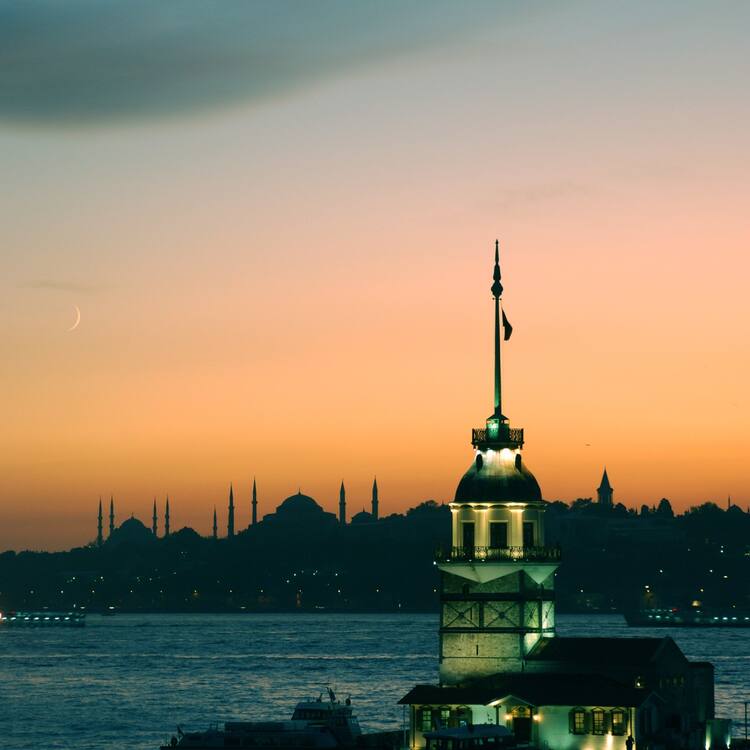
 View photos from OUR PLACE the World Heritage collection
View photos from OUR PLACE the World Heritage collection
